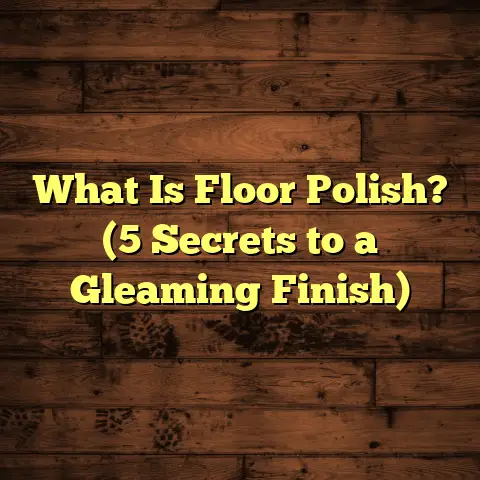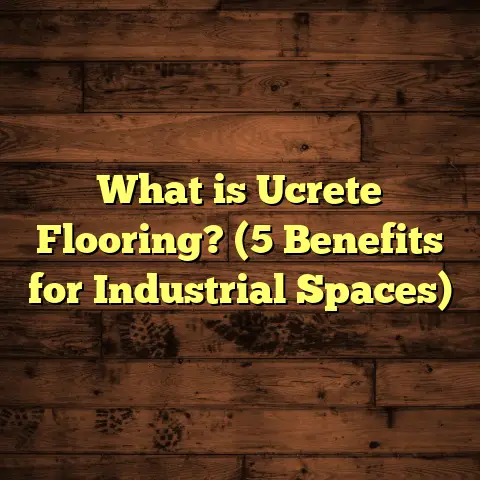What is Floor Trim Called? (5 Types You Need to Know!)
I’ll never forget the moment I truly understood the power of floor trim. I was working on a renovation for a client’s home—a beautiful mix of classic and modern styles. We had just finished laying down gorgeous hardwood floors, but something was missing. The floors looked great, but the walls felt bare, unfinished. When we added the right floor trim, suddenly the whole room snapped into place. It was like putting a frame around a painting. That small detail made all the difference.
If you’re anything like me, you might have overlooked floor trim at some point. Maybe you thought it was just a simple piece of wood along the wall or didn’t realize how many different types there are. But floor trim is more than just decoration—it’s an essential component of any flooring project. It covers gaps, protects your walls, and adds style and character.
In this article, I’m going to guide you through everything you need to know about floor trim: what it is, why it matters, and the five main types you should be familiar with. Along the way, I’ll share personal stories from my years in flooring installation, some data-backed insights, and practical tips that will help you make smart decisions for your own home or project.
Let’s get started.
What Is Floor Trim?
So, what exactly is floor trim? At its core, floor trim refers to the finishing materials installed where your flooring meets the walls or other surfaces. Its main job is to:
- Cover the expansion gap left between the floor and the wall during installation
- Protect walls from scuffs and damage
- Provide a polished, complete look to your flooring
Floor trim can be made from various materials like wood, MDF (medium-density fiberboard), PVC, or metal. It comes in different shapes and sizes depending on its purpose and style.
You might hear floor trim called by different names—baseboards, shoe molding, quarter round, T-molding, thresholds—but they all fall under the umbrella of floor trim.
Why Do We Need Floor Trim?
You might be wondering: if the gap is necessary, why not just leave it open? Well, there are several reasons floor trim is essential:
- Aesthetic appeal: An open gap looks unfinished, messy, and cheap. Trim creates a smooth visual edge that makes your flooring look professionally done.
- Protection: Trim protects walls from damage caused by furniture, vacuum cleaners, feet, and pets. Over time, these impacts can cause dents and scratches without trim shielding the base of the wall.
- Hides imperfections: Floors aren’t always perfectly level or walls perfectly straight. Trim hides small gaps and uneven edges.
- Soundproofing: Sealing gaps with trim cuts down on noise traveling between rooms or outside.
Here’s an interesting stat: A survey from the National Wood Flooring Association found that 85% of homeowners believe floor trim improves the overall look of their flooring by a large margin. So it’s not just me who thinks this way!
The 5 Types of Floor Trim You Need to Know
Over my years installing floors, I’ve worked with nearly every type of floor trim out there. Each one has its own specific use case and style vibe. I’ll break down the five most common kinds you’ll encounter.
1. Baseboards
Baseboards are the most familiar type of floor trim. They’re the tall boards running along the bottom of your walls where they meet the floor.
What baseboards do:
- Cover expansion gaps between wall and floor
- Protect walls from kicks, scuffs, and bumps
- Provide a decorative border that ties together your room’s design
Baseboards come in many profiles—from simple flat boards to ornate moldings with grooves or curves. Some are as short as 3 inches tall; others can be 6 inches or taller for a dramatic effect.
Personal story:
I once worked on a Victorian home where the original baseboards were 8 inches tall with intricate detailing. Matching that style took some extra work sourcing custom millwork, but it was worth it to preserve the home’s character.
Material options:
- Wood: Classic choice that can be painted or stained
- MDF: Budget-friendly and smooth for paint but less moisture-resistant
- PVC: Great for bathrooms or basements where moisture is an issue
Installation tips: Baseboards are nailed directly into wall studs using finishing nails. I always paint or stain them before installation—this helps avoid drips on your new floor.
2. Shoe Molding
Shoe molding is a smaller piece of trim that sits right at the baseboard-floor junction. It has a rounded shape that looks like a quarter circle.
Why use shoe molding?
- Covers any small gaps between baseboards and floor
- Masks uneven flooring edges
- Adds an extra layer of protection
I use shoe molding especially with hardwood floors because wood expands and contracts more than other materials. Shoe molding provides flexibility without bulk.
Fun fact: Shoe molding is sometimes called “base shoe” but it’s not exactly the same as quarter round (which is slightly larger).
Story from the field:
On one hardwood installation, we noticed some unevenness near walls. Baseboards alone didn’t hide it well enough, so we added shoe molding to finish it off perfectly.
3. Quarter Round
Quarter round looks similar to shoe molding but is usually thicker and bigger. It’s shaped like a quarter circle (hence the name) and typically sits at the base of baseboards covering wider gaps.
When to use quarter round?
- When floor gaps are larger or uneven
- With hardwood or laminate floors that need room to expand
- To create a more substantial trim look
I often recommend quarter round in older homes where subfloors are rarely perfectly flat.
Example:
During a remodel in a century-old home, we had uneven subflooring with spaces too large for shoe molding alone. Quarter round was perfect for hiding those gaps while adding charm.
4. T-Molding
T-molding is shaped like a “T” when viewed from above and is used to join two different flooring types at the same level.
Common uses for T-molding:
- Between hardwood and tile floors
- Between laminate and vinyl floors in adjoining rooms
- In open-concept spaces with multiple flooring materials
T-molding creates a smooth visual break without creating a trip hazard or bump.
Insight from data: According to HomeAdvisor research, using appropriate moldings like T-molding reduces wear along flooring edges by about 30%, helping floors last longer.
5. Thresholds (or Reducer Strips)
Thresholds are wider trims designed to bridge gaps between floors of different heights.
How thresholds work:
- They slope gently from one floor height down to another
- Used where hardwood meets carpet or tile that’s higher/lower
- Make walking between rooms safe and smooth
Personal experience: In one older home I worked on, subfloors weren’t level between rooms. Instead of costly leveling work, we installed reducer thresholds for a safe transition that looked professional.
How Do I Pick Which Floor Trim Fits Your Project?
Choosing trim can feel overwhelming because there are so many options. Here’s what I ask clients to narrow down choices:
- What type of flooring do you have? Wood? Tile?
- Is this a new install or replacement? Any existing trim?
- What style do you prefer: modern minimalism or traditional detail?
- Are adjacent rooms different flooring types or heights?
Answering these helps me pick baseboards for simple edges, shoe molding or quarter round for wood floors with expansion needs, or T-molding/thresholds for mixed flooring levels.
Materials Matter: What Should You Use?
Let’s talk about materials since they impact both appearance and durability.
Wood Trim
Wood is timeless with natural warmth and beauty. It can be painted or stained to match any decor.
- Pros: Durable, customizable finishes
- Cons: Can swell in moist environments
For living rooms and bedrooms, wood is my go-to choice.
MDF (Medium-Density Fiberboard)
MDF is engineered wood made from compressed fibers.
- Pros: Affordable, smooth surface for painting
- Cons: Not water-resistant; can swell if wet
I use MDF in dry areas where budget matters.
PVC/Vinyl Trim
PVC trim is plastic-based and moisture-resistant.
- Pros: Great for bathrooms/basements; won’t warp or rot
- Cons: Limited paint options; looks less natural
For bathrooms or laundry rooms with tile floors, PVC is perfect.
Metal Trim
Metal trims are rare in homes but popular in commercial spaces or ultra-modern designs.
- Pros: Sleek appearance; very durable
- Cons: More expensive; harder to install
Installation Tips From My Experience
Installing floor trim might seem easy but there are tricks that make it look professional:
- Measure carefully: Always double-check measurements before cutting trim pieces.
- Use a miter saw: For corners especially—cutting at 45 degrees allows neat joints.
- Fill nail holes: Use wood filler or caulk for clean finishes.
- Paint/stain before installation: This prevents drips on your new floors.
- Seal edges with caulk: This fills small gaps between trim and walls for a polished look.
- Leave room for expansion: Don’t nail trim too tightly against floors that expand.
How Much Does Floor Trim Cost?
Costs vary based on material type, style complexity, room size, and labor rates in your area.
Here’s a rough breakdown:
| Material Type | Price Per Linear Foot | Notes |
|---|---|---|
| Wood Baseboard | $1 – $4 | Classic choice |
| MDF | $0.50 – $2 | Budget-friendly |
| PVC/Vinyl | $1 – $3 | Moisture-resistant |
| Metal | $4 – $10 | Specialty use |
| Labor | $2 – $5 | Per linear foot |
Always add about 10% extra for waste since cuts don’t always match perfectly and mistakes happen.
When I’m budgeting projects nowadays, I use FloorTally—a tool that helps me calculate material needs and labor costs quickly based on local prices. It factors in waste percentages automatically which saves me time juggling numbers manually.
Stories From My Projects
Let me share some real-life examples of how choosing the right floor trim made all the difference:
Story One: The Floating Floor Challenge
A client wanted floating laminate floors with minimal visible trim because they loved the sleek modern look. We compromised by installing slim baseboards painted to match their walls paired with shoe molding painted to match floors. The effect was seamless yet practical—allowing expansion while keeping edges subtle.
Story Two: Historic Home Restoration
In a 1920s craftsman-style house remodel, matching original baseboard profiles was critical for authenticity. We sourced custom wood trims replicating original designs and stained them to blend perfectly with hardwood floors and built-in cabinetry—resulting in a stunning cohesive look true to period style.
Story Three: Moisture Problems Solved
A bathroom remodel had vinyl plank flooring with frequent moisture issues causing wood baseboards to warp previously installed by others. We switched to PVC baseboards and quarter round trims which resisted water damage beautifully over time.
Final Thoughts
Floor trim may seem like a small detail but trust me—it’s one of those things that pulls your whole space together visually and functionally.
From protecting walls to hiding gaps to reinforcing your design style, understanding what each type of trim does helps you make smarter choices when installing new floors or upgrading old ones.
If you’re tackling a project yourself or working with contractors, knowing about baseboards, shoe molding, quarter round, T-molding, and thresholds will keep you informed—and confident when discussing options.
And if estimating costs stresses you out like it used to stress me before I found good tools—try FloorTally for quick calculations tailored to your area and budget assumptions.
Got questions about your particular project or want advice on picking trims for your floors? Just ask—I’m here to help!
This wraps up my deep look into what floor trim is called and why those five types matter so much. Here’s hoping your next flooring project has that “aha!” moment too when everything clicks into place with just the right finishing touch.
If you want me to go even further on any specific type or need help estimating costs step-by-step using this info plus FloorTally data in action—let me know!





